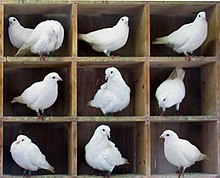pigeonhole principle
Jump to navigation
Jump to search
English[edit]

Etymology[edit]
From the commonly used expository example that if n+1 pigeons are placed in n pigeonholes, at least one pigeonhole must contain two (or more) pigeons.
Noun[edit]
pigeonhole principle (countable and uncountable, plural pigeonhole principles)
- (mathematics) The theorem which states that any partition of a finite set of n elements into m (< n) subsets (allowing empty subsets) must include a subset with two or more elements; any of certain reformulations concerning the partition of infinite sets where the cardinality of the unpartitioned set exceeds that of the partition (so there is no one-to-one correspondence).
- 1993, David Gries, Fred B. Schneider, A Logical Approach to Discrete Math, Springer, page 355:
- The pigeonhole principle is usually stated as follows.
(16.43) If more than n pigeons are placed in n holes, at least one hole will contain more than one pigeon.
The pigeonhole principle is obvious, and one may wonder what it has to do with computer science or mathematics.
- 2009, John Harris, Jeffry L. Hirst, Michael Mossinghoff, Combinatorics and Graph Theory, Springer, page 313,
- Of course our list of pigeonhole principles is not all inclusive. For example, more set theoretic pigeonhole principles are given in [72].
- Corollary 3.31 (Ultimate Pigeonhole Principle). The following are equivalent:
- 1. κ is a regular cardinal.
- 2. If we put κ pigeons into λ < κ pigeonholes, then some pigeonhole must contain κ pigeons.
- 2012, Dov M. Gabbay, Akihiro Kanamori, John Woods (editors), Handbook of the History of Logic: Volume 6: Sets and Extensions in the Twentieth Century, Elevier (North-Holland), page 325,
- As we turn to look at various pigeonhole principles and how they are used to prove partition theorems, particularly for pairs, we keep in mind the slogan that is embedded in the Motzkin quote: complete disorder is impossible.
Usage notes[edit]
An alternative formulation is that the codomain of an injective function on finite sets cannot be smaller than its domain. With this formulation, no restatement is necessary when infinite sets are considered.
The plural, strictly speaking, refers to formulations of the theorem.
Synonyms[edit]
- (theorem limiting size of codomains): Dirichlet's box principle, Dirichlet's drawer principle
Translations[edit]
combinatorial theorem
|
Further reading[edit]
 Pigeonhole principle on Wikipedia.Wikipedia
Pigeonhole principle on Wikipedia.Wikipedia  Multinomial theorem on Wikipedia.Wikipedia
Multinomial theorem on Wikipedia.Wikipedia  Ramsey's theorem on Wikipedia.Wikipedia
Ramsey's theorem on Wikipedia.Wikipedia  Dedekind-infinite set on Wikipedia.Wikipedia
Dedekind-infinite set on Wikipedia.Wikipedia  Hilbert's paradox of the Grand Hotel on Wikipedia.Wikipedia
Hilbert's paradox of the Grand Hotel on Wikipedia.Wikipedia